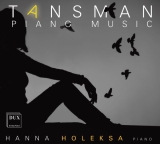Dux präsentiert eine Tansman-CD mit immer noch selten gespielten Tansman-Kompositionen, von denen die 24 Intermezzi das Hauptwerk sind. Der polnische Komponist, der ab 1919 in Frankreich (und während des Krieges in den USA) lebte, komponierte diesen Zyklus in den Jahren 1939 und 1940. Der Einfallsreichtum und die Vielfalt dieser Miniaturen sind bemerkenswert, ob in den schnell und rhythmischen oder den lyrischen Stücken.
Die polnische Pianistin Hanna Holeksa verfügt über eine solide Technik, die es ihr ermöglicht, Tansmans Musik souverän zu spielen, allerdings bleibt ihr Spiel insgesamt etwas blasser als das von Eliane Reyes (Naxos), die die Intermezzi besser differenziert und vor allem auch den gefühlsmäßigen Anforderungen besser gerecht wird.
Den ersten Satz der Fünften Sonate habe ich schon drängender und forscher gehört, das Lento ausdrucksvoller. Erst im dritten Satz, Molto vivace kommt etwas mehr rhetorische Kraft ins Spiel der Pianistin und auch im letzten Satz kann sie unser Interesse aufrechterhalten.
Die Aufnahmetechniker haben sehr gute Arbeit geleistet und ein angenehmes Hören ermöglicht.
Dux presents a Tansman CD with still rarely performed Tansman compositions, of which the 24 Intermezzi are the main work. The Polish composer, who lived in France from 1919 (and in the U.S. during the war), composed this cycle in 1939 and 1940. The inventiveness and variety of these miniatures are remarkable, whether in the fast and rhythmic pieces or the lyrical ones.
Polish pianist Hanna Holeksa has a solid technique that enables her to play Tansman’s music with aplomb, though her overall playing remains less inspired than that of Eliane Reyes (Naxos), who does a better job of differentiating the Intermezzi and, above all, of meeting the music’s emotional demands.
I have heard the first movement of the Fifth Sonata more urgent and brisk, the Lento more expressive. Only in the third movement, Molto vivace, does a bit more rhetorical force come into the pianist’s playing, and she is able to maintain our interest in the last movement as well.
The recording engineers have done a very good job and made for pleasant listening.
























